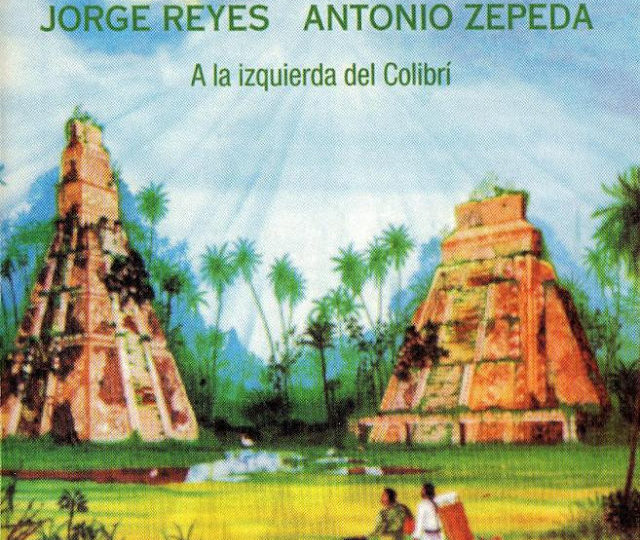
Jorge Reyes & Antonio Zepeda – A la izquierda del Colibri (1986)
Let’s be clear: electronic music didn’t begin in the 1980s. Innovations in electronic noise have been developing since the end of the 19th century. Both Italy and Russia had important Futurism or “Futurismo” movements that greatly advanced modern music. Each subsequent decade adding to the thinking, sounds and instruments musicians have at their disposal.
Nevertheless, electronic music did mature during the decade of the eighties into a recognizable mainstream platform by slowly crawling out of the experimental and avant-garde swamp of krautrock, dub and underground disco and changing expectations of popular music with what would develop into techno, new wave and synth-pop. Truth be told, the so called “reactionary decade” was a genuinely innovative and exciting time for music’s development. Maturing both philosophically and through the important technological developments that propelled the music forward (and into the mainstream). Firstly, the patenting of Leon Theremin’s electronic musical instrument in 1928 was an important jump in the development in sound. And the public’s eventual acceptance of that Theremin sound in the 70s and 80s. Secondly, and more importantly, the introduction of the Roland TR-808 synth between 1980/83. The 808 was the game changer- musicians now had the ability to generate new and unique sounds in electronic music, rather than sampling or manipulating sound. The result was an explosion of music that changed the musical landscape.
All of which resulted in an exciting and innovative period for the creation of new music. It’s interesting to note that this was also a confusing time for commercial radio. Why? Radio programmers and advertisers like stability and profits. Those ‘Rock Radio’ formats (among others) were safe, marketable, and popular with an affluent suburban audience. But changing media formats, like MTV at the time, changed all of that. Younger listeners, changing demographics and the need to fill a 24/7 music video show demanded the acceptance of greater varieties of music. For the first time, the old formats were blurring the lines between pop, rock, r&b and rap. Some interesting questions got asked- was Prince’s 1983 hit single “Little Red Corvette” a pop or rock song? Or funk or punk or dance? Was the Michael Jackson / Eddie Van Halen collaboration “Beat It” too much for conservative rock radio in 1982? And if so, why?
It is within that greater historical context of change that Mexico’s electronic musician Jorge Reyes and Antonia Zepeda, a specialist in pre-Hispanic and traditional Mexican instruments, began a collaboration that would expand the scope and journey of progressive electronic music even further. Originally released in 1985, the resulting album A la izquierda del Colibri is a little known but important work that is either a musical voyage into a world that never existed or a head-trip into the jungles of a future that we will never see. It doesn’t matter. Colibri an album of dense atmosphere and lush, wet textures of a jungle rain-storm. The wet heat of the morning fog as it settles into an ancient green valley. Our full vision is obscured with only moments of fleeting clarity provided. The call of the flute and chants weaving together with electronic backing are like a call from a spiritual world we don’t recognize. The music on Colibri is a glimpse of something buried deep within the human family. Difficult to find and impossible to pin down, but as true and real as the hand of Allah, or God.
A la izquierda del Colibri is the experimental music of a higher order. Reyes and Zepeda fuse together a detailed and delicate world using the electronic art rock of the 80’s and the sounds of ancient Mexico, the music employed long before the arrival of the Spanish on the continent. In fact, our only knowledge of this music is found as archaeological evidence from paintings, written descriptions, and the few instruments found: the C’antaros, the Teponaztili, and the Omichicahuaztli are all heard here. The musicians recreate the music of a deeply spiritual society built around the ideals of life, sacrifice, and offering. And like the transformative power of the 808 and the Theremin, the energy of innovation propels the music forward and inward. Every stroke of Zepeda’s percussion interplaying with the Reyes TR-700, the Poly 800 and various other synths and sequencers.
Reyes and Zepeda’s A la izquierda del Colibri is the rarest of records, a cornerstone of progressive, ambient-electronica. The album title, meaning “to the left of the hummingbird”, is a tribute to the Aztec deity, Huitzilopochtli (Hummingbird Left). This is music almost beyond our reach, providing an opening into the musical fabric between two worlds, a chance to look beyond the walls and formats constructed to separate and divide.
by Shawn Ciavattone

Your description is true to life. I was at a concert of zepeda and reyes in Malinalco Ruins in 1985 or 1986. It was mind blowing. I bought a tape of the concert which no longer exists because I played it constantly. It was a true spiritual experience. I,m glad theit music is being acknowledged.
Shawn,
This is a music with a sound that is both ambient and ancient, modern electronica meshed with tribal world music. Your description of the music as “lush, wet textures of a jungle rain-storm” and “wet heat of a morning fog as it settles into a green valley” are some of the pictures I imagine, as well–a sensual terrain.
Dig your recommendations, mate. This sounds beautiful.
Shawn,
I am very pleased with this review, thank you for showcasing one piece of Mexico’s enormous cultural wealth.
I saw this album two years ago in one of my favorite libraries. The sound of Ancient Mexico fuses with the landscapes of the ancient ruins. The experience feels like a relaxing walk in the beautiful Ruins of Chichén Itzá.
Fantastic read and record! ❤️
Excellent recommendation 👌 Bummed to have missed this reissue…
This sounds amazing 😮
Very interesting review to an absolutely beautiful album. It is one of my very favorite discoveries this year, a magical and transformative listening experience. Thank you for showing me this record.